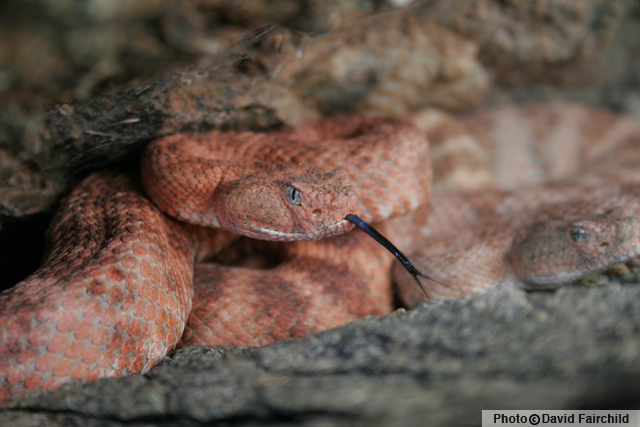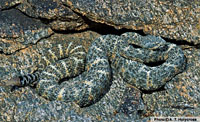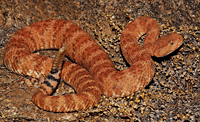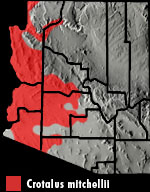Online Field Guide to The Reptiles and Amphibians of Arizona



Yavapai County, AZ
 Maricopa Co., AZ |
| SPECKLED RATTLESNAKE Crotalus mitchellii |
Venomous
|
| DESCRIPTION: A large rattlesnake (up to 1,295 mm or 51″ in total length excluding rattle) with extremely variable coloration. Specimens from the majority if its range in Arizona are rusty tan or dull pinkish-brown. Northwestern Arizona specimens are often pink or peach. Some specimens from the east-central part of its range in Arizona are off-white, pale gray, or pale blue-gray. Some specimens from the far southwestern part of its range in Arizona are off-white, cream, and tan. Its coloration and markings often match the rocks on which the animal lives. Markings consist of speckling and blotches that are somewhat scattered anteriorly and become more unified and band-like near the tail. The tip of the tail is usually marked with dark gray or black rings. The pupils are vertically elliptical and the dorsal scales are keeled. The neck is slender and the head is broad and triangular. On the end of the tail is a rattle composed of a series of loosely interlocking keratinous sections. A new section is added each time the snake sheds its skin. Its large head, and dark rings on the tail-tip distinguish it from the similar looking Tiger Rattlesnake.
DISTRIBUTION: This snake is distributed across western and southwestern Arizona at elevations ranging from just above sea level along the Colorado River to about 5,000′. HABITAT: An inhabitant of communities ranging from Sonoran Desertscrub and Mohave Desertscrub to the lower reaches of Interior Chaparral and Great Basin Conifer Woodland. It is usually found above the flats on rocky slopes, hillsides, steep bajadas, and rocky canyons. DIET: The Speckled Rattlesnake eats mice, rats, Chuckwalla lizards, smaller lizards, and birds. It uses venom injected through long, hollow, retractable fangs to kill and begin digesting its prey. REPRODUCTION: Mating takes place in spring. Young are born during the summer monsoon (July and August). REMARKS: This rattlesnake is capable of delivering large amounts of potent venom. If encountered it should be left alone. A large percentage of envenomations occur when a snake is handled or abused.By Thomas C. Brennan Bartlett. 2000. Snakes of North America: Western Region. Gulf Publishing Co. Houston, TX Brennan, T. C., and A. T. Holycross. 2006. A Field Guide to Amphibians and Reptiles in Arizona. Arizona Game and Fish Department. Phoenix, AZ Brennan, T. C., and A. T. Holycross. 2005. A Field Guide to Amphibians and Reptiles of Maricopa County. Arizona Game and Fish Department. Phoenix, AZ Fowlie. 1965. The Snakes of Arizona. Azul Quinta Press, Fallbrook, California Lowe, Schwalbe, Johnson. 1986. The Venomous Reptiles of Arizona. Nongame Branch Stebbins. 1985. Western Reptiles and Amphibians. Houghton Mifflin. New York, NY |
|
Visit Partners in Amphibian and Reptile Conservation:


HOME
Copyright © 2023, Arizona Game and Fish Department. All rights reserved.
If you make use of the textual contents of this site in reports, publications, etc. please cite and credit the author(s) and photographer(s). All photos on this website are copyrighted. However, those found in the species account section may be used for any noncommercial scientific, educational, or conservation purposes provided that photographs are not altered and continue to bear the copyright symbol and name of the photographer. Please contact the photographer regarding commercial use of copyrighted photographs.












